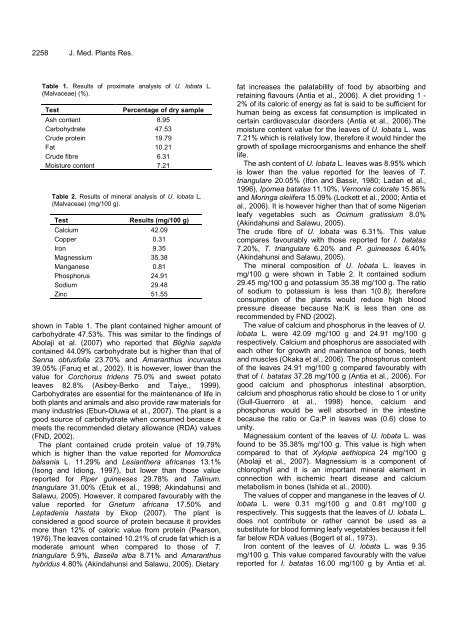Download Complete Issue - Academic Journals
Download Complete Issue - Academic Journals
Download Complete Issue - Academic Journals
You also want an ePaper? Increase the reach of your titles
YUMPU automatically turns print PDFs into web optimized ePapers that Google loves.
2258 J. Med. Plants Res.<br />
Table 1. Results of proximate analysis of U. lobata L.<br />
(Malvaceae) (%).<br />
Test Percentage of dry sample<br />
Ash content 8.95<br />
Carbohydrate 47.53<br />
Crude protein 19.79<br />
Fat 10.21<br />
Crude fibre 6.31<br />
Moisture content 7.21<br />
Table 2. Results of mineral analysis of U. lobata L.<br />
(Malvaceae) (mg/100 g).<br />
Test Results (mg/100 g)<br />
Calcium 42.09<br />
Copper 0.31<br />
Iron 9.35<br />
Magnessium 35.38<br />
Manganese 0.81<br />
Phosphorus 24.91<br />
Sodium 29.48<br />
Zinc 51.55<br />
shown in Table 1. The plant contained higher amount of<br />
carbohydrate 47.53%. This was similar to the findings of<br />
Abolaji et al. (2007) who reported that Blighia sapida<br />
contained 44.09% carbohydrate but is higher than that of<br />
Senna obtusfolia 23.70% and Amaranthus incurvatus<br />
39.05% (Faruq et al., 2002). It is however, lower than the<br />
value for Corchorus tridens 75.0% and sweet potato<br />
leaves 82.8% (Asibey-Berko and Taiye., 1999).<br />
Carbohydrates are essential for the maintenance of life in<br />
both plants and animals and also provide raw materials for<br />
many industries (Ebun-Oluwa et al., 2007). The plant is a<br />
good source of carbohydrate when consumed because it<br />
meets the recommended dietary allowance (RDA) values<br />
(FND, 2002).<br />
The plant contained crude protein value of 19.79%<br />
which is higher than the value reported for Momordica<br />
balsania L. 11.29% and Lesianthera africanas 13.1%<br />
(Isong and Idiong, 1997), but lower than those value<br />
reported for Piper guineeses 29.78% and Talinum.<br />
triangulare 31.00% (Etuk et al., 1998; Akindahunsi and<br />
Salawu, 2005). However, it compared favourably with the<br />
value reported for Gnetum africana 17.50% and<br />
Leptadenia hastata by Ekop (2007). The plant is<br />
considered a good source of protein because it provides<br />
more than 12% of caloric value from protein (Pearson,<br />
1976).The leaves contained 10.21% of crude fat which is a<br />
moderate amount when compared to those of T.<br />
triangulare 5.9%, Baseila alba 8.71% and Amaranthus<br />
hybridus 4.80% (Akindahunsi and Salawu, 2005). Dietary<br />
fat increases the palatability of food by absorbing and<br />
retaining flavours (Antia et al., 2006). A diet providing 1 -<br />
2% of its caloric of energy as fat is said to be sufficient for<br />
human being as excess fat consumption is implicated in<br />
certain cardiovascular disorders (Antia et al., 2006).The<br />
moisture content value for the leaves of U. lobata L. was<br />
7.21% which is relatively low, therefore it would hinder the<br />
growth of spoilage microorganisms and enhance the shelf<br />
life.<br />
The ash content of U. lobata L. leaves was 8.95% which<br />
is lower than the value reported for the leaves of T.<br />
triangulare 20.05% (Ifon and Bassir, 1980; Ladan et al.,<br />
1996), Ipomea batatas 11.10%, Vernonia colorate 15.86%<br />
and Moringa oleiifera 15.09% (Lockett et al., 2000; Antia et<br />
al., 2006). It is however higher than that of some Nigerian<br />
leafy vegetables such as Ocimum gratissium 8.0%<br />
(Akindahunsi and Salawu, 2005).<br />
The crude fibre of U. lobata was 6.31%. This value<br />
compares favourably with those reported for I. batatas<br />
7.20%, T. triangulare 6.20% and P. guineeses 6.40%<br />
(Akindahunsi and Salawu, 2005).<br />
The mineral composition of U. lobata L. leaves in<br />
mg/100 g were shown in Table 2. It contained sodium<br />
29.45 mg/100 g and potassium 35.38 mg/100 g. The ratio<br />
of sodium to potassium is less than 1(0.8); therefore<br />
consumption of the plants would reduce high blood<br />
pressure disease because Na:K is less than one as<br />
recommended by FND (2002).<br />
The value of calcium and phosphorus in the leaves of U.<br />
lobata L. were 42.09 mg/100 g and 24.91 mg/100 g<br />
respectively. Calcium and phosphorus are associated with<br />
each other for growth and maintenance of bones, teeth<br />
and muscles (Okaka et al., 2006). The phosphorus content<br />
of the leaves 24.91 mg/100 g compared favourably with<br />
that of I. batatas 37.28 mg/100 g (Antia et al., 2006). For<br />
good calcium and phosphorus intestinal absorption,<br />
calcium and phosphorus ratio should be close to 1 or unity<br />
(Gull-Guerrero et al., 1998) hence, calcium and<br />
phosphorus would be well absorbed in the intestine<br />
because the ratio or Ca:P in leaves was (0.6) close to<br />
unity.<br />
Magnessium content of the leaves of U. lobata L. was<br />
found to be 35.38% mg/100 g. This value is high when<br />
compared to that of Xylopia aethiopica 24 mg/100 g<br />
(Abolaji et al., 2007). Magnessium is a component of<br />
chlorophyll and it is an important mineral element in<br />
connection with ischemic heart disease and calcium<br />
metabolism in bones (Ishida et al., 2000).<br />
The values of copper and manganese in the leaves of U.<br />
lobata L. were 0.31 mg/100 g and 0.81 mg/100 g<br />
respectively. This suggests that the leaves of U. lobata L.<br />
does not contribute or rather cannot be used as a<br />
substitute for blood forming leafy vegetables because it fell<br />
far below RDA values (Bogert et al., 1973).<br />
Iron content of the leaves of U. lobata L. was 9.35<br />
mg/100 g. This value compared favourably with the value<br />
reported for I. batatas 16.00 mg/100 g by Antia et al.

















